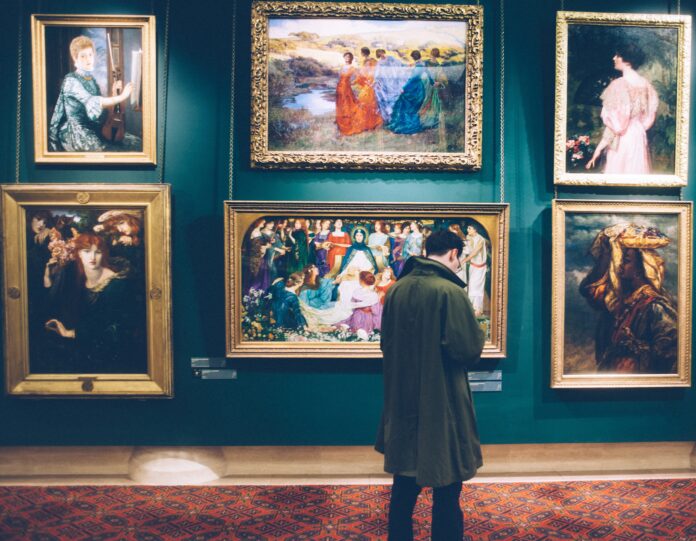Painting, an age-old art form, continues to captivate and inspire individuals around the world. In this article, we delve into the intricate world of painting, its historical significance, the fundamental elements that shape its beauty, diverse techniques employed by artists, various styles and movements that have defined its evolution, and its enduring relevance in modern society.
Historical Background:
Painting has a rich history, dating back to prehistoric times when early humans used natural pigments to create cave paintings. Over centuries, painting techniques and styles evolved, influenced by iconic artists like Leonardo da Vinci, Vincent van Gogh, and Pablo Picasso. These pioneers laid the foundation for the exploration of new artistic possibilities.
Elements of Painting:
- Color: Color plays a vital role in painting, evoking emotions, setting moods, and conveying meaning. From vibrant palettes to subdued tones, artists carefully select and mix colors to create powerful visual narratives. Understanding color theory and its application allows artists to create harmonious and impactful compositions.
- Composition: Composition refers to the arrangement of elements within a painting. Artists employ various techniques to achieve balance, harmony, and focal points. Through the strategic placement of objects and the use of principles such as the rule of thirds, artists guide the viewer’s eye and create engaging visual experiences.
- Light and Shadow: The skillful use of light and shadow adds depth, dimension, and realism to a painting. Artists explore different approaches, such as chiaroscuro or the dramatic interplay of light and shadow, to create striking visual effects. The manipulation of light not only enhances the aesthetic quality but also influences the emotional impact of the artwork.
- Texture: Texture in the painting adds a tactile dimension and visual interest. Artists experiment with various techniques to create different textures, from smooth and polished surfaces to rough and textured brushstrokes. Texture can evoke sensations, create illusions, and provide a unique sensory experience to the viewer.
Painting Techniques:
- Brushwork: Artists use brushes of different shapes, sizes, and bristle types to achieve desired effects. Brushwork can vary from delicate and precise strokes to bold and expressive gestures. Mastery of brushwork allows artists to control the flow, texture, and overall impression of their artwork.
- Palette Knife: Palette knife painting offers a distinct and textured approach to painting. Artists use a palette knife, a flat tool with a flexible steel blade, to apply thick layers of paint. This technique allows for a more expressive and impasto style, creating striking visual textures and capturing the energy of the subject.
- Glazing and Layering: Artists employ glazing and layering techniques to build depth, transparency, and luminosity in their paintings. Glazing involves applying transparent layers of paint over dried layers, while layering involves building up multiple layers of paint. These techniques offer a range of effects, from creating subtle color shifts to achieving a rich and multidimensional appearance.
- Wet-on-Wet and Wet-on-Dry: Artists employ different approaches when working with wet paint. Wet-on-wet refers to applying wet paint on a wet surface, resulting in blending and soft edges. In contrast, wet-on-dry involves applying wet paint on a dry surface, allowing for more control and precise details. These techniques offer flexibility and different expressive possibilities.
Styles and Movements in Painting:
- Realism: Realism focuses on capturing the subject matter with meticulous attention to detail and accuracy. Artists like Gustave Courbet and Edward Hopper exemplify this style, creating lifelike representations that provoke contemplation and reflection. Realism remains relevant in contemporary painting, offering a window into the everyday world.
- Impressionism: Impressionism emerged in the 19th century, challenging traditional painting techniques. Artists such as Claude Monet and Pierre-Auguste Renoir sought to capture fleeting moments and the play of light. Their loose brushwork, vibrant colors, and emphasis on capturing atmosphere revolutionized the art world, leading to the birth of a new artistic movement.
- Abstract Expressionism: Abstract Expressionism emerged in the mid-20th century, embracing spontaneity, emotion, and non-representational forms. Artists like Jackson Pollock and Willem de Kooning pushed the boundaries of painting, using gestural brushstrokes, vibrant colors, and abstract compositions to express inner turmoil, personal narratives, and universal themes.
Contemporary Approaches to Painting:
In today’s art world, painters continue to explore new frontiers. Artists experiment with unconventional materials, fuse traditional and digital techniques, and push the boundaries of subject matter. This experimental approach creates diverse and thought-provoking artworks that challenge the status quo and redefine the possibilities of painting.
The Significance of Painting in Modern Society:
- Preserving Cultural Heritage: Painting plays a crucial role in preserving cultural heritage, capturing historical moments, and conveying societal values across generations. Artworks act as powerful visual records, reflecting the beliefs, struggles, and triumphs of societies throughout history.
- Expression of Personal and Collective Narratives: Painting serves as a medium for personal and collective expression, allowing artists to communicate their thoughts, emotions, and perspectives. It provides a platform for diverse voices and narratives, fostering dialogue and understanding within society.
- Therapeutic Benefits: Engaging in painting offers therapeutic benefits, promoting relaxation, self-expression, and mindfulness. Many individuals find solace in the creative process, using painting as a means to alleviate stress, express emotions, and connect with their inner selves.
Conclusion:
The art of painting continues to enthrall and inspire, blending tradition and innovation. Through the exploration of historical context, fundamental elements, diverse techniques, and various styles and movements, we gain a deeper appreciation for the immense beauty and expressive power of painting. As we embrace the significance of painting in modern society, let us continue to support and celebrate the artists who enrich our world with their extraordinary creations.
And as always folks be sure to check out the Mojo Patrakar and read some of the latest interesting articles in Hindi. Also, check out the latest article on GGF Discover the Perfect Starting Point: Top 5 Beginner-Friendly Anime for Newcomers.









